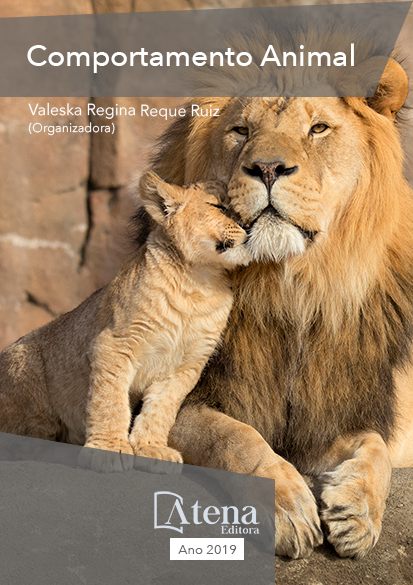
Influência de técnicas de enriquecimento ambiental no comportamento de Alouatta caraya (humboldt, 1812) (Primates: Atelidae) cativos no Parque Zoobotânico Getúlio Vargas, Salvador, Bahia
Restrição de espaço e falta de
estímulos, sejam físicos, sociais ou motores,
são algumas, dentre outras circunstâncias
encontradas em ambientes cativos, que podem
comprometer o padrão natural de atividades dos
indivíduos cativos e levar a baixos níveis de bemestar. Técnicas de enriquecimento ambiental
têm sido frequentemente empregadas em
ambiente cativo com o intuito de proporcionar
uma melhora nos recintos desses animais,
tornando-os mais dinâmicos e estimulando os
animais a explorá-los de maneira mais efetiva.
Este estudo avaliou a influência de diferentes
técnicas de enriquecimento no repertório
comportamental de dois indivíduos adultos
(um macho e uma fêmea) de Alouatta caraya
(Humboldt, 1812) mantidos cativos no Parque
Zoobotânico Getúlio Vargas, Salvador, Bahia,
Brasil. As observações ocorreram entre os
meses de agosto de 2011 e junho de 2012
e foram divididas em quatro fases: controle
ou pré-enriquecimento; enriquecimento
sensorial; enriquecimento alimentar e pósenriquecimento. Para observação foi utilizado o
método animal-focal com registro instantâneo a
cada 30 segundos, o que totalizou 120 registros
por fase para cada indivíduo. A frequência dos
atos comportamentais exibidos nas diferentes
fases de enriquecimento foi comparada com
a da fase controle através do teste Wilcoxon.
Na fase controle, dos 14 atos comportamentais
exibidos, ambos indivíduos apresentaram
apenas 6 destes, sendo destaque o ato
Descansar e Observar. Embora estes sejam
atos comuns e frequentemente expressos em
ambiente natural, a não expressão de uma
maior variedade de atos pode ser um indício
de baixo grau de bem-estar, condicionado
por um ambiente empobrecido. Durante a fase experimental, apesar da biologia
da espécie ter sido considerada na elaboração dos enriquecimentos, os indivíduos
continuaram a despender grande parte do seu tempo ao Descanso e Observação.
Não houve diferença significativa entre os comportamentos observados antes e após
os enriquecimentos, tanto para o Macho (W=11; p=1,00) quanto para a fêmea (W=14;
p=0,93). Os resultados demostram que A. caraya no Parque Zoobotânico necessita de
uma maior atenção. Ambiente físico amplo e estímulos variados e frequentes podem
melhorar a condição de A. caraya, inclusive podendo obter melhora reprodutiva.
Influência de técnicas de enriquecimento ambiental no comportamento de Alouatta caraya (humboldt, 1812) (Primates: Atelidae) cativos no Parque Zoobotânico Getúlio Vargas, Salvador, Bahia
-
DOI: 10.22533/at.ed.7351925016
-
Palavras-chave: comportamento, primatas, cativeiro, Atelidae, enriquecimento
-
Keywords: behavior, primates, captivity, Atelidae, enrichment.
-
Abstract:
Restriction of space and lack of stimuli, whether physical, social or motor,
are some, among other circumstances found in captive environments, which can
compromise the natural pattern of activities of captive individuals and lead to low levels
of well-being. Environmental enrichment techniques have often been employed in a
captive environment in order to provide an improvement in the enclosures of these
animals, making them more dynamic and stimulating the animals to explore them
more effectively. This study evaluated the influence of different enrichment techniques
on the behavioral repertoire of two adult individuals (one male and one female) of
Alouatta caraya (Humboldt, 1812) kept captive in the Getulio Vargas Zoobotanical
Park, Salvador, Bahia, Brazil. Observations occurred between August 2011 and June
2012 and were divided into four phases: control or pre-enrichment; sensory enrichment;
food enrichment and post-enrichment. For observation, the animal-focal method with
instantaneous recording was used every 30 seconds, which added up to 120 records
per phase for each individual. The frequency of the behavioral acts exhibited in the
different stages of enrichment was compared with that of the control phase through
the Wilcoxon test. In the control phase, from the 14 behavioral acts recorded, both
individuals presented only 6 of these, emphasizeing the acts of Resting and Observing.
Although these are common acts and often expressed in the natural environment, the
non-expression of a greater variety of acts may be an indication of a low degree of
well-being, conditioned by an impoverished environment. Even though the biology of
the species is considered in the elaboration of the enrichment, during the experimental
phases individuals continued to spend much of their time at Rest and Observation.
There was no significant difference between the behaviors observed before and after
enrichment, for both male (W=11, p=1.00) and female (W=14, p=0.93). The results
show that A. caraya in the Zoobotanical Park needs more attention. Ample physical
environment and varied and frequent stimuli can improve the condition of A. caraya,
including reproductive improvement.
-
Número de páginas: 15
- Airan dos Santos Protázio
- Jacileide Santos Silva Lima
- Téo Veiga de Oliveira
- Denise Costa Rebouças Lauton


